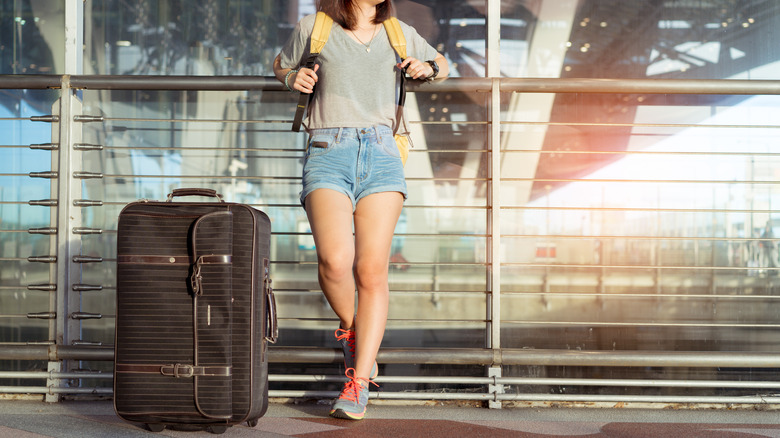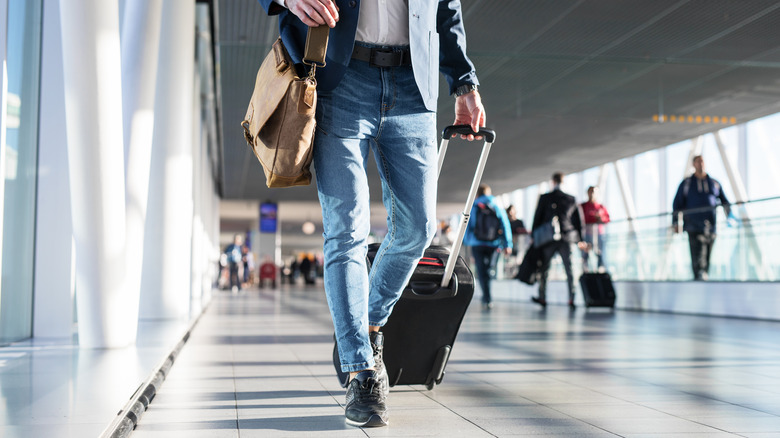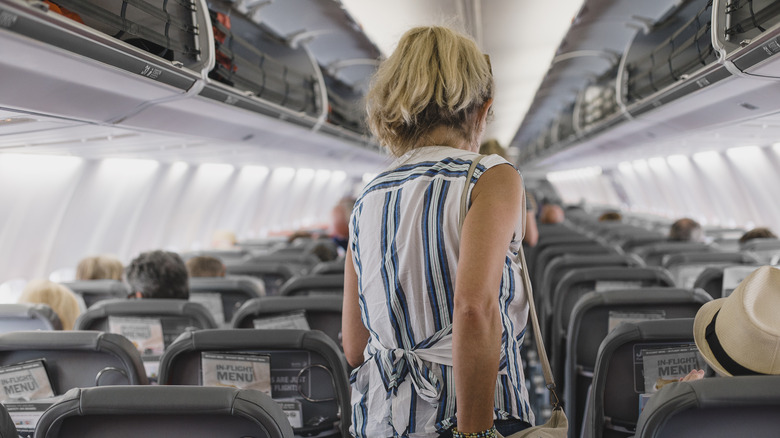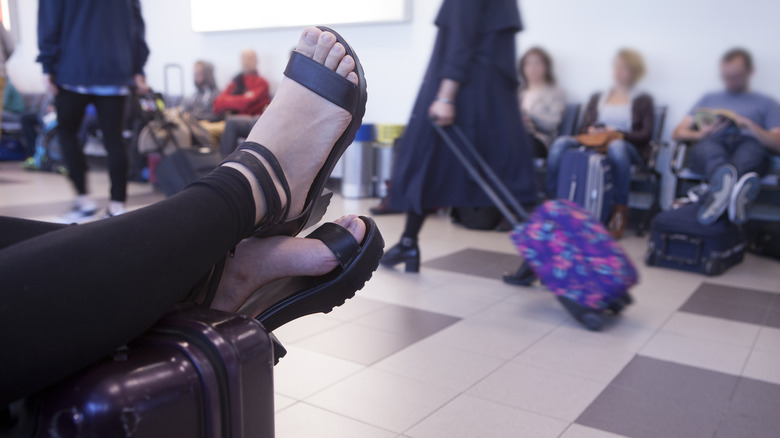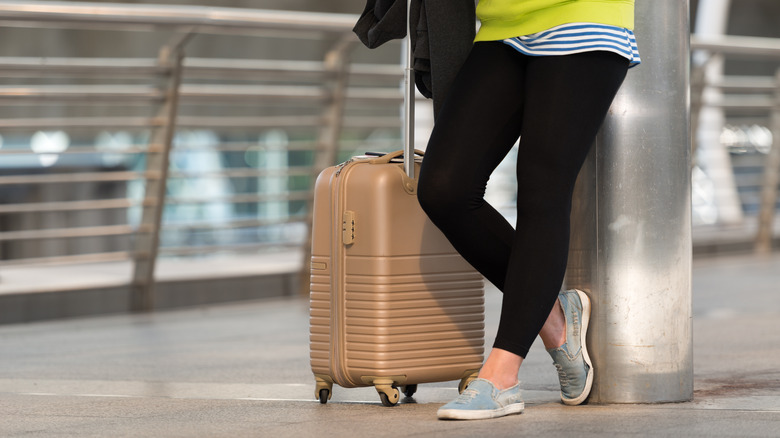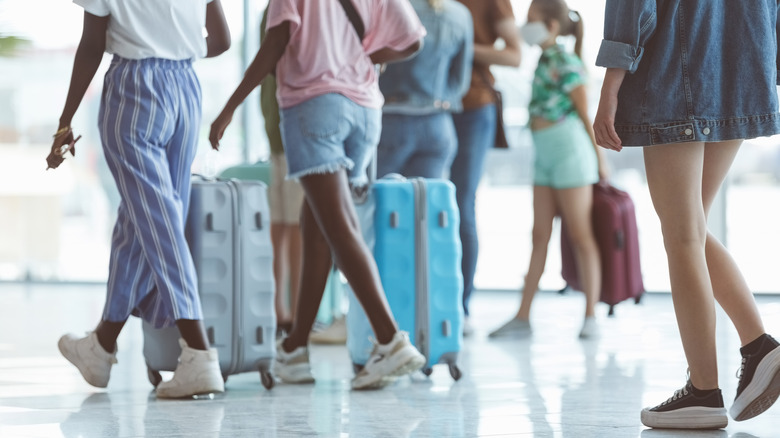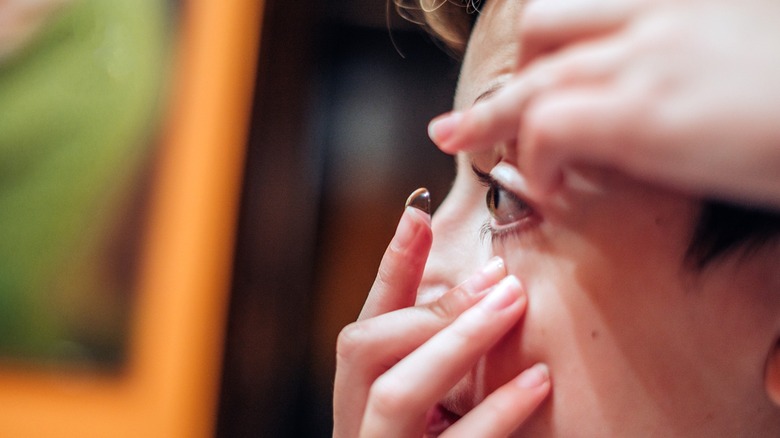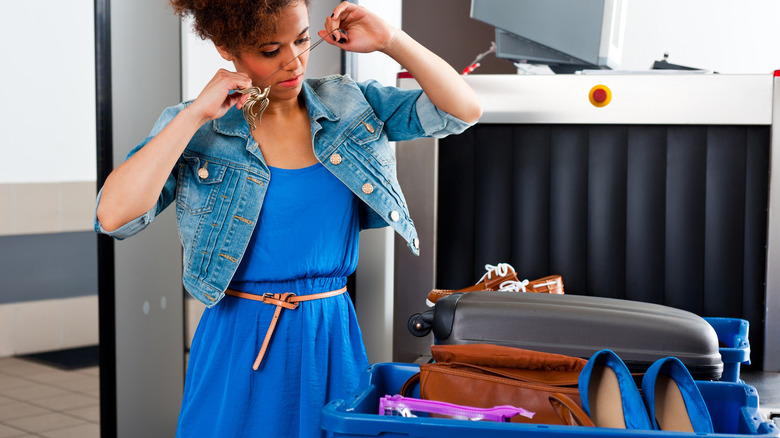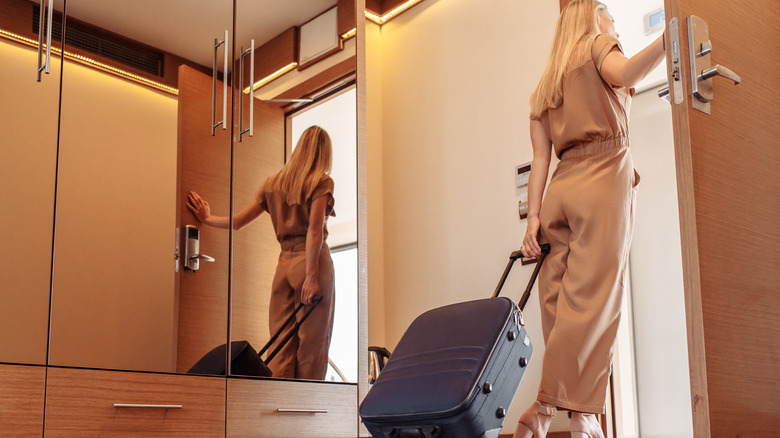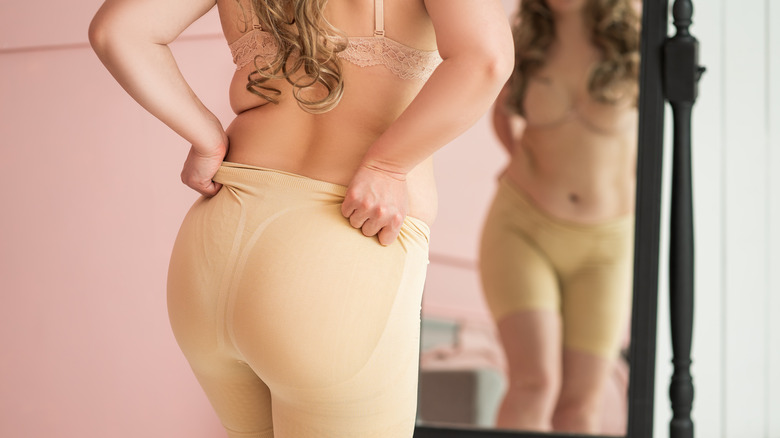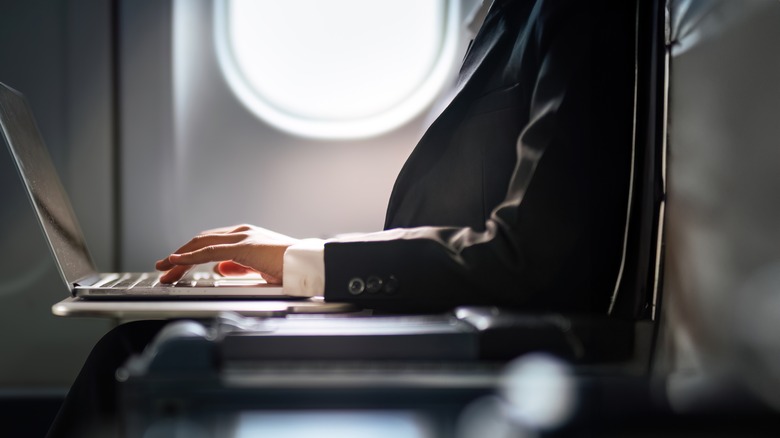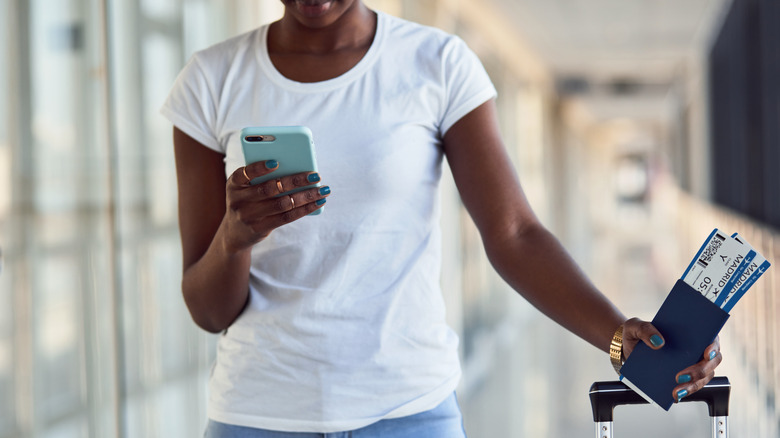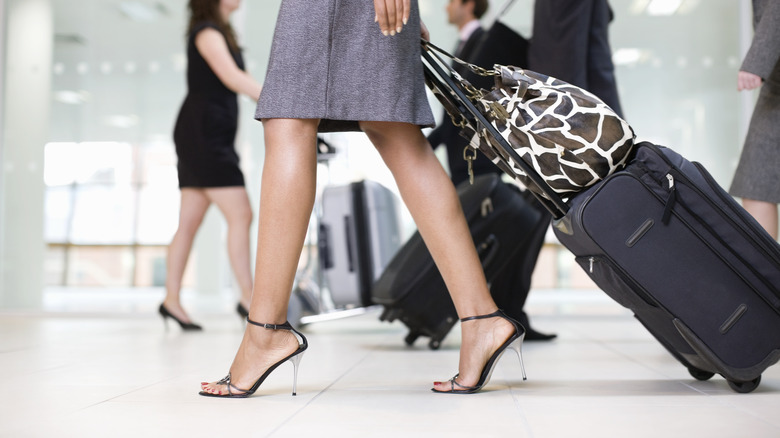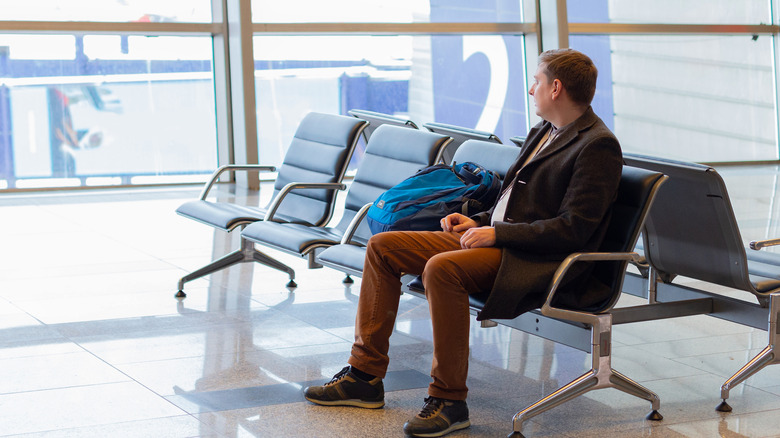Things You Should Never Wear On A Plane
People generally put a lot of thought into the outfits they pack in their suitcases for travel. The foremost outfit that deserves attention, however, is not always granted the careful consideration it needs: your airport look. It marks the very beginning of your travel journey and deserves equal, if not more, planning as the ensembles you intend to wear at your destination. Dressing up for a flight is more than just about style. A proper airport ensemble should be tailored for optimum functionality, keeping you ideally comfortable throughout your travel journey — all the way from your departure to your arrival gates.
The airport experience, as well as the flight journey, is influenced by a number of factors not within the control of travelers. An emergency evacuation, for instance, might require passengers to unforeseeably exit the aircraft. While they may not guarantee a smooth deplaning process, certain wardrobe choices — like closed footwear and snug-fit clothes — can minimize the risk of hazards. Similarly, it's a good idea to take into account clothing recommendations from the TSA to make security checks easier. Here is a list of things not to wear on the plane or to the airport to make your life easier (especially if you're a first-time flier).
Skinny jeans
Whether or not a pair of jeans constitutes comfortable in-flight attire has long been a bone of contention within the travel community. Now, with the popularity of wide-legged denims that cover a whole relationship spectrum — from mom jeans to boyfriend jeans — the debate has only been blown open wider. The most convincing argument the pro-denim camp offers is that the weight of jeans is better worn than carried in one's luggage. The opposition, however, can hardly be persuaded into enduring stiff denim trousers for a flight journey where space is likely to be constricted anyway. Both fair points.
Loose jeans offer a reasonable middle ground. Ditch those skinny denims for a pair that is more relaxed and allows for healthy circulation of blood and easy movement. Flying has a physical impact on the human body, and sitting immobile for extended periods of time puts people at a risk of conditions like deep vein thrombosis (DVT) or blood clotting that can show up as swelling or pain. Wearing comfy clothes can make things easier and safer, especially on longer flights.
Skin-baring tops
Have you ever found yourself feeling colder inside an airplane than you usually do? That was not your imagination taking flight — pun intended! In-flight temperatures are intentionally kept low for a variety of reasons that range from preventing passenger sickness at higher altitudes to ensuring efficient functioning of aircraft systems. To that end, travelers taking off from warm destinations can expect to find airplane cabins colder by several degrees, but this temperature whiplash can be mitigated by what you wear — and don't wear.
Tops that expose too much skin may not be your best bet inside a flight, even if they proved ideal for the weather conditions you were in before boarding. Wearing a top that neither overheats you nor leaves you freezing is a good idea. An even better one is layering. If a tank top is what you are most comfortable traveling in, go for it. But have a jacket or thin shawl on hand to slip under once you begin feeling that chill. Some airlines do provide blankets — yes, even to economy travelers – but it's best to bring your own backup that is both light to carry and warm enough to keep you at ease throughout your journey.
Open-toe footwear
Slipping on a pair of flip-flops or sandals for the airport seems like a harmless choice to make — and a comfortable one, to say the least. But travel experts and experienced travelers seem to agree that any kind of open-toe footwear for air travel is not a good call. For starters, airports are a thriving hotspot of germs. "A few common skin conditions your bare feet [can] easily catch by walking through airport security barefoot: athlete's foot, toenail/skin fungus, [and] plantar warts," Dr. Joseph E. Mechanik wrote for the Colorado Foot Institute. Knowing that, it's probably best to keep your feet as covered as possible.
Open-toe slippers can also prove to be an impediment in emergency situations that require passengers to evacuate the aircraft and, in case of a crash, navigate hazards like shattered glass, flames, or even dangerous terrain. When you're in an emergency, the last thing you want to be worried about is injuring your foot. While sandals do make getting through security checkpoints a breezier affair in comparison to shoes, in the larger scheme of things, shoes are a safer option.
Leggings
This one might seem like a head-scratcher, we know. Leggings, after all, are one of the most preferred items of clothing among travelers. Not only are they versatile enough to be styled multiple ways, the stretchy comfort they offer is unparalleled. What's more, leggings have only grown as a popular fashion aesthetic, as the Lululemons of the world take over TikTok trends. All points considered, one would think that leggings or yoga pants are a great go-to choice for air travel, right? Wrong.
Athleisure items like leggings are made from synthetic materials such as nylon and polyester, which are purpose-built for workouts. While they are ideal for the gym, wearing them on a flight could prove to be risky in adverse situations. "Everyone is wearing yoga pants on planes now, but I avoid all artificial [fibers] because they are more likely to burn and stick to you if there is a fire," Christine Negroni told The Sun, highlighting a situation where passengers may have to make an emergency exit in case of a crash or other disaster. According to her, wearing natural fibers like cotton is the smarter choice.
Shorts
Wearing a pair of shorts to the airport might seem like a fair idea. For starters, they're never out of fashion. Another significant reason is that the comfort they offer is unparalleled. Shorts enthusiasts usually have at least one pair in their wardrobes they can practically live in. And what better occasion than a painstaking flight journey, where comfort will be a priority? Comfortable or not, don't wear shorts on a flight.
Shorts — or any article of clothing that leaves too much of your body uncovered — don't make for the best airport attire, on account of the germs they expose you to. A flight attendant said it best in a TikTok video that went viral, revealing the truth behind wearing shorts on a plane. "You never know how clean the seat is going to be — so if you have pants, you're going to have less germs," @tommycimato warned viewers, ticking off a list of other in-flight etiquettes to consider.
Contact lenses
Contact lenses come with quite a few terms and conditions, all of which may not be met during air travel. For starters, the air in plane cabins is drier than what people are used to on the ground. "The pressure, temperature and oxygen levels in the cabin fluctuate, and the humidity level is lower than it is at sea level," Florida physician Dr. Matthew Goldman told Cleveland Clinic. It's why flying can cause the body to feel dehydrated and aggravate dry-eye symptoms. For people wearing contacts, this could spell additional discomfort.
While there are certainly ways around it — like using rewetting drops – the hassle might just not be worth it. If you can, switch out your lenses for that trusty pair of glasses, at least for the duration of your flight. Your eyes will thank you. When traveling with lenses, also be mindful of the Transportation Security Administration (TSA) guideline that notifies about possible screenings or inspections for contact lens solution (especially those in larger bottles).
Metal jewelry
Very chunky jewelry or other metal accessories are best avoided during air travel. The extra glam they add to your travel wardrobe comes at the cost of longer wait times during security checks and delays that can well be avoided. While the TSA does not regulate the kind of jewelry one can and cannot wear on flights, there are some odd reasons TSA may require additional screening.
When it comes to traveling with valuable jewelry, the TSA advises against stowing it away in your checked luggage. Keeping them on your person — in a carry-on or cabin baggage — is a safer proposition, though anything too striking might still necessitate extra checks. Passing through airport security is already a pretty intimidating process. Don't add to your stress by wearing or carrying too much jewelry that could cause a security hold up.
Jumpsuits or rompers
Imagine slipping into a chic jumpsuit for your air journey only to realize mid-flight that you need to use the bathroom. Maneuvering a jumpsuit in a regular toilet is hard enough. Doing it in an airplane toilet that hardly offers space for the gymnastics required to unfasten this outfit would presumably be a whole other ball game. The same goes for rompers or, for that matter, any kind of attire that requires one to drop their clothes to the floor or sit topless on the toilet seat.
Sure, outfits of this kind have no dearth of advantages: They are easy to style, comfortable to carry, and snazzy to look at. But the one foreseeable downside they have trumps them all, as far as convenient in-flight attire is concerned. The thought of stripping down to nothing to do your business — all the while being vigilant about not letting any part of your jumpsuit touch the constricted interiors of an airplane bathroom — is enough to send even the most seasoned traveler into a spiral. Maxi dresses are a better alternative for people keen on wearing one-piece outfits for air travel.
Strong perfumes
The thought of being boxed in with dozens of people (and their respective odors) for an extended period of time could tempt you to douse yourself in perfume before a flight. In truth, doing that will be antithetical to the problem. Strong scents — no matter how delicious-smelling they may seem — can aggravate the senses of people nearby, even causing headaches and breathing difficulties for some. Inside a plane, that becomes a risky proposition. As manners expert Adeodata Czink told The Seattle Times, "It bothers the people seated around you, and they can't leave the plane."
What does one do about the persistent issue of in-flight smells, then? Masks are more fashionable than ever in our post-pandemic world and provide an easy way out of awkward situations, like having to sit with odorous neighbors on a flight, without the risk of offending anyone. Another solution is to relay the concern to the cabin crew, who might be able to move your seat elsewhere or take other necessary steps, in accordance with airline policies.
Synthetic underwear or shapewear
Wearing breathable undergarments becomes doubly important during air travel, which requires people to be cramped in the same place in the same clothes for extended periods of time — not to mention the use of public bathrooms and possibly long hours at the airport. Comfort will be paramount, and simple underwear made of natural fabrics will be your best friend. Save those synthetic body-shapers and designer thongs for when you reach your destination.
The underwear you pick out for your travel journey should preferably be breathable, have moisture-wicking qualities, be comfortably sized, and offer odor resistance. Garments made of cotton fibers check those boxes better than synthetic materials like nylon, spandex, satin, and polyester, which tend to prevent healthy air flow down there and can even trigger infections. Dr. Andrea Braden, an Atlanta-based OB-GYN, offered a good rule of thumb for anyone confused by underwear choices: "It should be soft and not slippery" (via HuffPost). And for people unable to decide between boxers and briefs, we say go for the latter. A snug protective fit is likely to be more comfortable than a loose fit that encourages chafing or is constantly bunching up.
Formal suits
It's easy to spot a corporate traveler. The clothes they wear are usually the giveaway — because who else would suit up in their formal best in the wee hours of the morning? While the effort they put into dressing up that early is worthy of appreciation, there is a predictable (and avoidable) liability that threatens the tidiness of their travel attire: wrinkles. Being cramped into the tiny seat of a plane for a prolonged period of time is bound to leave creases on your crisply pressed suit.
You don't want to head to work looking disheveled when you land. Fortunately, there are practical ways around this. Invest in a sturdy garment bag that allows full-size clothing to be stored without disfigurement. Another trick is to use tissue paper to keep your clothes wrinkle-free in a suitcase. Here's a useful explainer on how to pack a suit in a carry-on. Remember to follow the baggage allowance limit and dimensions specified for carry-on luggage before you get packing.
Light colors
Wearing light-colored clothes during air travel is just another way to invite trouble. Whether it's an unforeseen coffee spill, sweat stains, or a dirty flight seat, a small misfortune could stand to ruin your whole outfit. No matter how classy they look, pastel shades carry an inherent risk of being easily soiled — and noticeably so. That's why it is always a safer bet to wear darker colors to the airport. Blacks, blues, and other deeper hues travel better, minimizing chances of a possible faux pas caused by any spilling or soiling accidents.
Besides being a sensible fashion choice for air journeys, darker clothes also serve to protect you against possible sun exposure on flights. As Dr. Dendy Engelman, a New York-based dermatologist, told Verywell Health: "Any exposure to UV rays can lead to skin damage. The higher in altitude, the higher dose of radiation you receive." So aside from slathering on sunscreen before boarding a flight, it is also a good idea to dress in dark clothes that will absorb ultraviolet radiations better than a light-hued ensemble.
Stilettos
The power of a good stiletto cannot be overstated. From ramps to red carpets, high heels remain evergreen and their fashion quotient, unmatched. But one place where this style statement does more harm than good is at the airport. High heels easily rank near the top on the list of shoes that shouldn't be part of your travel attire, for the simple reason that they don't always guarantee balance or agility and can hinder movement during emergency situations that may require people to be quick on their feet.
Imagine being late for a flight and having to run across the airport in stilettos. It would not be an easy feat, even for those experienced in the superhuman skill. Stilettos are also likely to become an obstacle during more critical in-flight settings. In case of an emergency evacuation, for instance, passengers will be better equipped to deplane using the evacuation slide if they are in flat footwear that neither restricts mobility nor is sharp-edged.
Bulky coats
It is reasonable to have warm clothing on hand if you are flying out from, or landing at, a destination with a colder climate. Despite the logic, the in-flight journey can quickly become uncomfortable if the winter coat you have on is too bulky or heavy. First, there is the obvious issue of limited space. And while the regulated temperature inside aircrafts leans towards the colder side, there may be instances, as The New York Times has pointed out, of cabins sometimes overheating to the point where people can feel unwell.
The stiff frame of a winter coat will also make it difficult to fold and stow away for the duration of a flight. Remember, it is not proper flight etiquette to take up space in the overhead bin by storing your jackets and coats there. Instead of a bulky coat, you will want to choose a coverup that is lightweight and easy to fold into a packing cube that can fit inside your carry-on.
